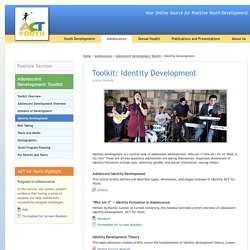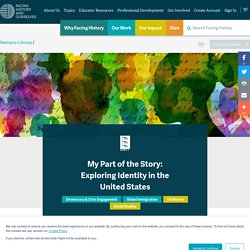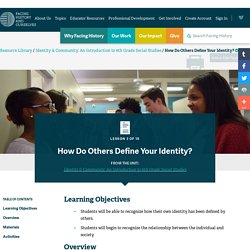

ACT for Youth - Adolescent Development Toolkit - Identity Development. Identity development is a central task of adolescent development.

Who am I? How do I fit in? What is my role? These are all key questions adolescents are asking themselves. Unit: My Part of the Story: Exploring Identity in the United States. What is the identity of the United States, and how do I fit into it?

My Part of the Story is a collection of six lessons designed to launch a course about United States history, literature, or civic life through an examination of students’ individual identities. Adolescence is a time when many young people struggle with issues of independence, trust, freedom, and responsibility. It is also a time when life centers around peer groups and mutual relationships. What Shapes Your Identity? This lesson is part of the unit Identity & Community: An Introduction to 6th Grade Social Studies The previous lesson introduced students to the term identity and encouraged them to think about the factors that shape their own identity.

This lesson includes activities to deepen and broaden students’ ideas about identities. Elizabeth Acevedo Introduces ‘The Poet X’ Honoring My Students' Names. Radio Rookies. Tavi Gevinson: A teen just trying to figure it out. How Do Others Define Your Identity? This lesson is part of the following unit:Identity & Community: An Introduction to 6th Grade Social Studies In the first two lessons, students engaged in activities in which they answered the question, “Who am I?”

Yet, even as we struggle to define our unique identity, we are being defined by others. Sometimes groups attach labels to us that differ from those we would choose for ourselves. In the book The Bear That Wasn’t, Frank Tashlin uses words and pictures to describe that process. Tashlin tells the story of a bear who is told again and again that he is a “silly man who needs a shave and wears a fur coat.” In the following lessons, students will explore the relationship between the individual and society by looking at how their own identities are influenced by others. Warm-up This warm-up exercise prepares students for reading The Bear That Wasn’t by helping them think about how the labels others use to describe us are sometimes different from the ones we choose for ourselves.
"Hair" by Elizabeth Acevedo. Radio Rookies. Chimamanda Ngozi Adichie: The danger of a single story. Celebrating Diversity - Recommended Reading - LibGuides at American Library Association. Young Adults/Teens - Recommended Reading - LibGuides at American Library Association. Diversity, Equity And Justice. Losing Language. Facing History in New York, in partnership with WNYC Radio’s Radio Rookies program, helps public high school students develop digital storytelling skills through the Neighborhood to Neighborhood project.

Each year, students in the program tackle complex questions about identity, race, education, and crime and violence in their communities. Using interviewing skills and multimedia tools, the students produce original visual and audio pieces.This post is the third in a five-part series introducing their finished pieces. Each post will include connection questions you can use in your classroom to discuss the works or to start your own project. This week: Two friends look at the relationship between language and identity. Check back next Tuesday when we hear from a group of teens talking about how their fashion reflects their personality. Words Matter. How does it feel to be called by a name you did not choose for yourself?

Over time, people have used a long list of names for the Indigenous Peoples of the Americas, but those words have rarely been what they would call themselves. The power and meaning of labels comes not only from the choice of words but also from how those words are said. Niin, an Anishinaabe woman of both Cree and Ojibway descent, talked in an interview about the first time in her childhood when someone called her an “Indian.” I’m not sure whether I was in grade one or in grade two; actually I think it was in kindergarten, because my Mom was home at that time.
I remember being outside for recess. Las Palabras Importan ¿Qué siente una persona cuando la llaman por un nombre que no eligió para usted? El poder y el significado de las etiquetas no solo proceden de la elección de las palabras, sino también de la forma como se dicen. Choice Words. In productive classrooms, teachers don't just teach children skills: they build emotionally and relationally healthy learning communities.

Teachers create intellectual environments that produce not only technically competent students, but also caring, secure, actively literate human beings. Choice Words shows how teachers accomplish this using their most powerful teaching tool: language. Throughout, Peter Johnston provides examples of apparently ordinary words, phrases, and us...read more Choice Words shows how teachers accomplish this using their most powerful teaching tool: language. Throughout, Peter Johnston provides examples of apparently ordinary words, phrases, and uses of language that are pivotal in the orchestration of the classroom.
This book will be enlightening for any teacher who wishes to be more conscious of the many ways their language helps children acquire literacy skills and view the world, their peers, and themselves in new ways. Literacy, Learning, Thinking, and Classroom Communities.